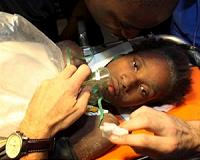| . |  |
. |
Paris (AFP) March 31, 2010 For ages, mankind has craved a tool that can provide early warning of that terrifying moment when the earth begins to shake. But if a scientific paper published on Wednesday is confirmed, we may at last have found one. The best hope yet of an earthquake predictor could lie in a small, brown, knobbly amphibian, it suggests. The male common toad (Bufo bufo) gave five days' warning of the earthquake that ravaged the town of L'Aquila in central Italy on April 6, 2009, killing more than 300 people and displacing 40,000 others, the study says. Biologist Rachel Grant of Britain's Open University embarked on a toad-monitoring project at San Ruffino lake, 74 kilometres (46 miles) north of L'Aquila, 10 days before the 6.3-magnitude quake struck. Her two-person team observed the site for 29 days, counting toad numbers and measuring temperature, humidity, wind speed, rainfall and other conditions. By March 28, more than 90 male toads had mustered for the spawning season, but two days later, their numbers suddenly fell, Grant reports. By April 1 -- five days before the quake -- 96 percent of the males had fled. Several dozen ventured back on April 9 for the full moon, a known courtship period for toads, although the tally was some 50-80 percent fewer than in previous years. After this small peak, the numbers fell once more, only picking up significantly on April 15, two days after the last major aftershock, defined as 4.5 magnitude or higher. In addition, the number of paired toads at the breeding site also dropped to zero three days before the quake. And no fresh spawn was found at the site from April 6 until the last big after-tremor. Grant says the toads' comportment is a "dramatic change" for the species. Once male toads hole up at a breeding site, they usually never leave until the annual spawning season is over, she notes. Eager to answer the riddle, Grant obtained Russian measurements of electrical activity in the ionosphere, the uppermost electromagnetic layer in the atmosphere, which were picked up by very low frequency (VLF) radio receivers. The toads' two periods of exodus both coincided with bursts of VLF disruption. Previous research has attributed perturbations in the ionosphere to releases of radon, a radioactive gas generated underground, or to gravity waves prior to a quake, although much about this phenomenon is unclear. In the quest to find an earthquake predictor, elephants, horses, wolves, snakes and fish have all been variously put forward. This study, though, is exceptional. It puts the flesh of data and first-hand observation on the bones of anecdotal evidence, even if there is no confirmed explanation as to why the toads bolted as they did. "Our study is one of the first to document animal behaviour before, during and after an earthquake," says Grant. "Our findings suggest that toads are able to detect pre-seismic cues such as the release of gases and charged particles, and use these as a form of early warning system." The paper is published in the Journal of Zoology by the Zoological Society of London.
Share This Article With Planet Earth
Related Links Bringing Order To A World Of Disasters When the Earth Quakes A world of storm and tempest
 Garbage boy beats the odds at Haiti slum hospital
Garbage boy beats the odds at Haiti slum hospitalPort-Au-Prince (AFP) March 28, 2010 Erod holds onto the bars of his cot and smiles, oblivious to his own amazing survival story 10 weeks after being left to die in a mound of stinking garbage following Haiti's earthquake. Found in a chronically malnourished state, the 18-month-old boy was taken to a hospital in the Port-au-Prince slum of Cite Soleil where Medecins Sans Frontieres (MSF) returned to run things after the January ... read more |
|
| The content herein, unless otherwise known to be public domain, are Copyright 1995-2010 - SpaceDaily. AFP and UPI Wire Stories are copyright Agence France-Presse and United Press International. ESA Portal Reports are copyright European Space Agency. All NASA sourced material is public domain. Additional copyrights may apply in whole or part to other bona fide parties. Advertising does not imply endorsement,agreement or approval of any opinions, statements or information provided by SpaceDaily on any Web page published or hosted by SpaceDaily. Privacy Statement |